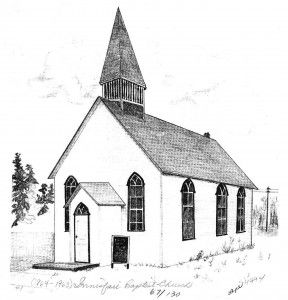 With the arrival of war, worship services of many Baptist churches in America are disrupted. Among congregations canceling monthly services (other than in cities and large towns, once-a-month services are common in Baptist life at this time, owing in no small degree to the difficulty of transportation) after the beginning of sectional hostilities is Providence Baptist Church of Sandy Springs (later renamed First Baptist Sandy Springs) of Dunwoody, Georgia.
With the arrival of war, worship services of many Baptist churches in America are disrupted. Among congregations canceling monthly services (other than in cities and large towns, once-a-month services are common in Baptist life at this time, owing in no small degree to the difficulty of transportation) after the beginning of sectional hostilities is Providence Baptist Church of Sandy Springs (later renamed First Baptist Sandy Springs) of Dunwoody, Georgia.
Still a young church when the war begins, Providence’s history to this point has been immersed in the divisive issue of slavery. Formed in 1853 with eleven charter members, the church’s first meeting house was built by slaves. As recounted on the church’s website:
Providence Baptist Church was born in troublesome times: gold had recently been discovered in California. The population began to move westward. New states were joining the Union and there was the big question of Free States or Slave States.
In the little community of Dunwoody and down by the “Sandy Spring” there was conversation about the newly inaugurated President, Franklin Pierce, and his newly appointed Secretary of War, Jefferson Davis. People talked about the possibility of annexing Cuba to be a Slave State, thereby giving the South more representation in Congress. They were very interested in a new book by Harriet Beecher Stowe – a best seller called “Uncle Tom’s Cabin.” Some states had banned distributions of this book –
making it all the more popular. The young men who read this book were soon to be th voters of 1860 and the soldiers of 1861.Occasionally, the conversation around the brush arbor and the hitching posts would turn to higher things. The leader of these conversations always seemed to be a tall young man with a coal black beard. He was W.G. Akin, landowner, Baptist deacon, preacher, and one of God’s called leaders. He always spoke of the need for a house of the Lord for worship, fellowship, and prayer. God put it on Mr. Akin’s heart and he felt the need to set aside part of his own land for a church house. This land was near the present site of New Hope Cemetery in Dunwoody.
The first building was a one-room log cabin with red clay for mortar, built by slaves under the supervision of Mr. Akin. It was heated by a fireplace with a stick and dirt chimney. Logs were split into shingles for the roof, and split logs with peg legs were used for benches.
Now no longer meeting for worship, the little flock of Providence Baptist remains apart until the end of the war, at which time some members yet living are reunited.
Source: “A New Beginning: The History of First Baptist Church Sandy Springs” (link)